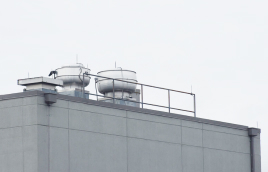Lightning Protection Systems for Distilleries
Lightning is a hazard to all types of structures. It is an especially high risk to buildings that contain highly volatile and combustible products. Lightning protection for distillers can save your structure from a devastating blow. Ethyl alcohol-water solutions with a flashpoint of 100F degrees or less are extremely flammable. This means that beverages with approximately 20 percent alcohol content (40 proof) or more are combustible. The alcohol in distilleries is frequently far in excess of this level; alcohol content may be as high as 95% (190 proof) neutral spirits but is normally aged at about 65% (130 proof) and bottled at 40% (80 proof). Under the right conditions, these mixtures can even be explosive.
The danger is well known. One only has to recall the 2003 fire at a distillery in Bardstown, KY that burned so intensely it created “firenadoes” and destroyed approximately 19,000 barrels of bourbon. More recently, on July 2019, lightning ignited a fire that destroyed an even more staggering quantity – 45,000 barrels of whiskey – aging in a warehouse in Woodford County, KY. Similar disasters have occurred repeatedly throughout the modern era.
Fortunately, techniques to protect against lightning are also well known. This is thanks in no small part to Ben Franklin. While he is best known for his treatise, “How to Manage the Distilling of a Spirit from Rye, or other Grain,” Franklin also experimented with lightning and established the principles of lightning protection. In the two and a half centuries since then, his discoveries have been confirmed and improved upon so that we can now enjoy a variety of distilled delights, plus affordable and proven lightning protection systems.

Beyond these catastrophic events, other types of hazards merit attention:
- The potential release of large quantities of alcohol into the environment can kill wildlife and damage ecosystems. At the Woodford County incident, for example, alcohol from the collapsing rickhouse flowed into an adjacent stream and created a toxic plume that killed fish and other animals downstream.
- Lightning surges fry electronic systems and devices used to control operations, security, lighting, communications, and other vital systems. This is especially a concern in highly automated warehouses and distribution centers. Surge damage occurs more frequently than reported because of A.) Damage to a circuit board or computer chip is often too small to see. And, B.) Damage to a device may not be immediately obvious; by the time the defect is found, memory of a lightning storm in the vicinity may have passed. In situations like these, defects and downtime are typically and incorrectly attributed to product defects or normal wear and tear.
- The cost to local communities for fighting fire, remediating damaged natural systems, and the loss of jobs can be huge.
- With the growing popularity of beverage tourism, such as the Kentucky Bourbon Trails, distillers take on responsibility for the safety of their visitors on their property.
Does your building require lightning protection?
Risk Assessment:
Guidelines for evaluation of lightning hazards are in National Fire Protection Association (NFPA) 780 – Standard for the Installation of Lightning Protection Systems, Annex L, “Lightning Risk Assessment.” The assessment can be easily conducted online.
According to the Standard, the following considerations increase the risk to many distilleries:

Many distilleries are located in regions of high lightning density. Note, however, that even regions with relatively low density are at risk.

The rooftop equipment, silos, and tanks at distilleries are often the tallest structures in an area, giving them increased exposure to lightning strikes.

A building’s horizontal expanse also increases the risk of lightning strikes. This is especially important due to recent trends towards enormous warehouses and distribution centers. Note, however, that even small, craft distillers are at risk and require lightning protection.

In addition to the combustibility of distilled spirits, oak barrels and heavy timbers used to construct many distillery buildings are also fuel for a fire. Dust from grain handling and storage operations is also highly combustible and explosive.

Many distilleries are landmarks in their communities, structures that create a sense of identity and pride. Some are even listed in the National Register of Historic Places. Visitors come from around the world to be in their presence and savor a sense of place. The destruction of such structures diminishes our ability to appreciate the importance of distilling in American history.
Insurance and Regulatory Requirements:
Recommended Fire Protection Practices for Distilled Spirits Beverage Facilities, published by The Distilled Spirits Council of the United States, Inc. sets NFPA 780 as the bar for lightning protection systems. The publication further states, “lightning protection should be provided” for buildings and structures housing:
- Grain handling operations.
- Still houses.
- Alcohol handling and storage operations.
- Barrel warehouses.
- Used barrel storage.
Barrel Storage of Distilled Spirits – GAP.8.1.0.1, published by Global Asset Protection Services LLC, a property risk engineering and loss prevention group working with distillers, also requires lightning protection in accordance with NFPA 780.
Design and Installation Considerations:
A lightning protection system requires a whole building approach. The system must comply with nationally-recognized standards, including LPI 175, UL 96A, and the previously mentioned NFPA 780. These standards have been vetted by peer-reviewed studies based on extensive field and laboratory research.
The standards call for a network of air terminals (lightning rods), lightning conductors, and ground electrodes to create multiple safe, low-resistance paths between the top of a structure (including rooftop equipment) and the earth. All wiring and services passing through the building envelope must be protected with surge protective devices. The structural system, major pieces of equipment, HVAC, plumbing, and other metallic systems within the building have to be bonded to achieve electrical equipotential, and all the facility’s grounding systems have to be interconnected.

Whether building a new facility or renovating an older building, a lightning protection system can be integrated into a building’s architecture in a sensitive manner.
A lightning protection specialty contractor, certified by the Lightning Protection Institute, should be part of the design and construction team. The lightning protection system professionals must collaborate with the architects, electrical and systems engineers, and construction team to assure proper design and installation of the lightning protection system.
Inspection and certification under the Lightning Protection Institute – Inspection Program (LPI-IP) should be part of building commissioning. Operating and maintenance staff and vendors must be trained to work around the lightning protection system. For example, installation of new equipment may require connections to the lightning protection system, and caution must be used to maintain the lightning protection system's integrity when performing rooftop work.
Typical industrial buildings should be reinspected every two to five years and whenever the building is remodeled. Distilleries have more rigorous requirements, however. According to Recommended Fire Protection Practices for Distilled Spirits Beverage Facilities, bonding and grounding should be visually inspected monthly, and testing should be performed annually to verify resistance to ground.
Further Information:
“Small Scale, High Proof,” National Fire Protection Association, 2013
Photos courtesy of A-1 Lightning Protection Consultant Co., LLC, Cecilia, KY
Our Partner:

visit www.sls-us.com to learn about their suite of lightning solutions for special applications



